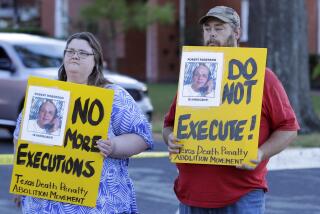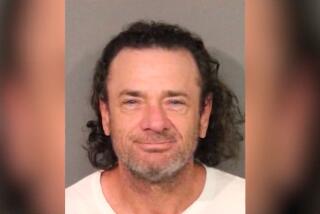Jury Deadlocks on Sentence in Murder Trial
A double murderer who killed a mother as she picked up her daughter from Bible study was spared the death penalty Thursday by two holdout jurors.
After about a week of weighing whether Etienne Moore, 25, was such a dangerous, manipulative killer that he deserved to die, as prosecutors sought, or whether the former high school basketball star was, as defense lawyers described, a good-hearted young man with something left to offer, jurors sent a note to the judge Thursday indicating there was nothing left to discuss. They simply could not agree.
Los Angeles County Superior Court Judge J.D. Smith, who earlier this week asked the jury to try again after they told him they had reached an impasse, this time agreed they were hopelessly deadlocked and declared a mistrial.
Prosecutors now must decide whether to retry Moore or to accept the default penalty of life without the possibility of parole.
“I’d be lying if I said I wasn’t disappointed,” said Deputy Dist. Atty. Janice Maurizi, the lead prosecutor on the case. “I don’t think there’s such a thing as closure, but I think there’s a measure of justice to be had that right now has been denied.”
Larry Hicks, whose deeply religious sister, Laurie Myles, was killed by Moore outside the Northridge house where her daughter was studying the Bible, said the jury’s indecision was a crushing disappointment.
“I don’t believe he deserves to live for one second past this verdict right here,” Hicks said. “Etienne Moore is a violent killer. For us to have to listen to this decision just deepens the already excruciating pain that we’ve all been dealing with for five years, 10 months and two weeks.”
Moore’s mother, Eileen Lyons, would say only: “It’s not over yet. We believe in miracles.”
The mistrial capped a nearly four-month trial during which Moore and two crime partners, LaCedrick Johnson and Shashonee Solomon, were each convicted of at least one murder.
“We shouldn’t lose sight of the fact that we took three very dangerous guys off the street forever,’ said Deputy Dist. Atty. Edwin Greene, who prosecuted the case with Maurizi. “In this kind of a case, I think it was no small accomplishment. It is very satisfying.”
Despite the enticement of a large reward, and intense media coverage, authorities did not zero in on a suspect in the Myles killing for more than a year.
Not until after Moore was arrested in the unrelated shooting of an off-duty police officer, and Los Angeles Police Department Det. Robert Bogison decided to compare ballistics in that crime with the Myles killing. The same gun had been used in both cases.
The jury also convicted Moore, who authorities say was the triggerman in the Myles slaying, of killing Talin Kara Tarkhanian for Solomon in 1993. Prosecutors said Solomon ordered the killing in part because he was angry with her over breaking off their romantic relationship and Moore carried it out to win “stripes” in his gang.
Jurors did agree that Solomon and Moore were part of a group of men who committed dozens of follow-home robberies in the San Fernando Valley.
Myles was just another robbery victim--one who apparently got nervous and did not hand over her purse and suitcase quickly enough, authorities said. The North Hills woman was shot in front of her then-9-year-old son, who brought tears to some jurors’ eyes as he described his fruitless efforts to save her with mouth-to-mouth resuscitation and to drive the car to safety.
Jurors convicted Solomon of Tarkhanian’s murder, but could not agree whether his actions met the special circumstances legally required before the death penalty can be considered. Smith declared a mistrial in the penalty phase of that case last month.
In Moore’s penalty trial, defense lawyers had argued that their client was too young to be put to death--he was 19 at the time of the murders. Among their witnesses were his mother and two pastors from Faith Baptist High School, where he excelled in basketball. They told jurors that the Moore they knew was a good person whom they thought incapable of the crimes he had been convicted of committing.
Michael Adelson told jurors that growing up without a father left his client without the structure that could have made him a productive citizen.
Maurizi told jurors that Moore’s criminal career, from his first arrest for shoplifting in 1990 to the Tarkhanian murder, showed an increase in violence. She said he had been caught with a shank, a sharpened weapon, and handcuffs while in custody awaiting trial, had attacked other inmates and had started a fire in his cell. That, she said, showed he would always be dangerous.
“He wants you to feel sorry for him because he wasn’t able to be a basketball star,” Maurizi said. “He had the support of a loving family. He had everything handed to him. . . . I ask you not to let him manipulate you into sympathy that’s not warranted by the facts of this case.”
The four-man, eight-woman jury voted 10-2 for death on the special circumstances in Myles’ murder and 9-3 for execution in the Tarkhanian murder.
Prosecutors said they will decide by next month whether to take a second shot at the death penalty with another jury.
They have also yet to decide whether to retry Johnson or Solomon on the unresolved charges and special circumstance allegations.
More to Read
Sign up for Essential California
The most important California stories and recommendations in your inbox every morning.
You may occasionally receive promotional content from the Los Angeles Times.










